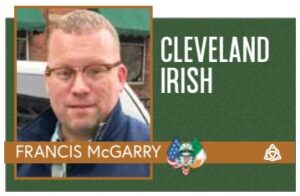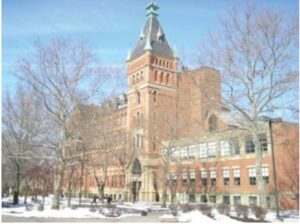John Carroll
 John William Heisman was born in Cleveland on October 23, 1869. He lived at 3928 Bridge Avenue.
John William Heisman was born in Cleveland on October 23, 1869. He lived at 3928 Bridge Avenue.
Jay Berwanger of the University of Chicago was the first recipient of the Heisman Trophy. Back then, the Maroons were in the Big Ten and known as the “Monsters of the Midway.” Gerald Ford once tackled Berwanger. No future president tackled Charles McNeil. He received a master’s from Chicago in 1925, created the point spread, made millions gambling, and taught JFK at the Choate School. It was founded in 1890, the same year as the University of Chicago and the same year John Carroll University was incorporated under Ohio law to confer certificates and degrees.
JCU was St. Ignatius College then, founded by the Society of Jesus in 1886. St. Ignatius College was originally at West 30th and Carroll Avenue, less than a half-mile from Heisman’s house. In 1920, St. Ignatius College added football, and in 1923 it bought 60 acres of land in what would become University Heights. St. Ignatius College was renamed Cleveland University briefly and then John Carroll University in September 1923. The JCU campus is about eight and a half miles from VASJ (Villa Angela St. Joseph).
Desmond Howard, the only Cleveland-born Heisman Trophy winner, played at Joe’s with fellow VASJ Hall of Famer and Bluestone President Bob Mullin. Bluestone is everywhere, but not so much in Columbus, where Heisman winner Troy Smith was born.
CLEVELAND IRISH FRANCIS MCGARRY
John Carroll est. 2006 WRITING FOR 9 YEARS
John Carroll was the fourth of seven children of Irish immigrant Daniel Carroll (1696-1751) and Eleanor Darnall (1703-1796); her family was wealthy planters who were active in the colonial government in Maryland. Eleanor, atypical for most colonial women, received a formal education at a convent school in Flanders. Like many Catholic landed gentry in England at the time, her family chose to send her to a Jesuit school in Europe.
During the rule of Elizabeth I, Catholic education was subject to the Penal Laws. As a result, multiple English recusant Catholic schools were established in proximity to areas of oppression. That oppression and practice followed colonial Catholics in America. Maryland was established in 1634 with an ethos of religious freedom, at least within those who consulted the New Testament.
The Glorious Revolution in 1688 made Maryland a royal colony. In 1704, Catholics in Maryland were forbidden from practicing their faith, voting, or holding government office. Catholic priests were required to forfeit any property to the colony.
Signers of the Articles of Confederation and the Declaration of Independence
It was Eleanor Carroll who homeschooled her children, including Daniel Carroll II, signer of the Articles of Confederation and the US Constitution. John and his cousin Charles, who signed the Declaration of Independence, both then studied at Bohemia Manor, a clandestine Catholic school in Maryland. At the age of 13, John was sent to the College of Saint Omer in Flanders with his cousin Charles. Five years later, in 1753, John Carroll joined the Society of Jesus, also known as the Jesuit Order. He was ordained in 1761, and ten years later was formally professed as a Jesuit.

Pope Clement XIV’s Dominus ac Redemptor, following the kings of Europe, officially suppressed the Society of Jesus. Carroll returned to America, and Maryland, to join his fellow ex-Jesuits. At the time, anti-Catholic and anti-Jesuit were often synonymous. They created the “Gentlemen of Maryland” as a legal entity to maintain their properties and continued their missionary work. Their properties were mainly plantations, encompassing over 15,000 acres. Those plantations grew tobacco with enslaved African labor.
The Constitution of the Clergy, authored by Carroll, was discussed and accepted in 1783-1784. It was the first step in the creation of an American Catholic Church; it included rules of life and financial relationships. Carroll introduced a strongly democratic clerical form of church administration. The genesis of his task was negotiating a context of religious pluralism in a “state” that is (post-Revolution) religiously neutral and where the ideals of freedom of conscience, the exercise of religion for all, and the toleration of religious divergence was the official law.
John Carroll was living in a time of the Enlightenment, the American Revolution, and the founding of the American Catholic Church. Catholics were less than 1% of the national population. John Carroll also had a plan. He worked to maintain the right of the Holy See and ensure the autonomy of the local church. After serving as the Superior of the Missions in America during the colonial period, and then the Apostolic Prefect of the United States, he was consecrated in 1790 as the first Bishop of Baltimore.
Bishop Carroll
As Bishop, he understood the need of the church to cope with the political and social context. His task was to structure the intersections of the republicanism of a new America and the history of the Church. This influenced his approach to the Holy See as the mission of the faith and the organized national Church as an autonomous representative of the Catholic community. No national Church could exist devoid of its own clergy and a way to sustain its own clergy. He wanted the American Catholic Church to be seen as such, and not as foreign. Priests immigrating to the US were required to study the Constitution, and liturgy should be in English, not Latin. It was the parishioners who annually rented pews who should vote for trustees to run the church’s temporal affairs.
John Carroll envisioned an American Catholic university to assist in this transition. He believed it was essential to the survival and growth of the Catholic faith in America. It would be an academy to provide a classical education. Georgetown was founded in 1789 as a space to attract students and recruit for the priesthood. Carroll believed a seminary would follow. As fate would have it, Father James Emery, Superior of the Society of St. Sulpice in Paris, offered to establish and fund a seminary for the new Diocese of Baltimore. St. Mary’s Seminary was opened in 1791. The Society of St. Sulpice was concerned with the political climate in Revolutionary France.
Bishop Carroll was a man of historical awareness at a critical point in history for the Catholic church, and the Catholic university, in America. He passed away in 1815, 11 years before the first Mass in Cleveland. Carroll had established the foundation that later members of the Irish Diaspora, priests, and laity alike, could utilize to further grow and sustain the American Catholic Church.
John Carroll University
Our diocese was initially administered by Irish immigrant priests, not American educated as Carroll envisioned. It was Bishop Gilmour (1872-1891) who was fundamental in the founding of John Carroll University. Gilmour was born in Scotland and attended seminary at Mount St. Mary’s in Maryland. He understood the importance of Catholic higher education, like Carroll, and he possessed diocesan autonomy due to the efforts of Bishop Carroll.
Irish Game Day
This year on October 12, John Carroll University football plays Capital in University Heights. It is the first Irish Game Day and inaugural Shamrock Game. It is an opportunity to support local Catholic higher education and venerate those who preceded us in establishing the American Catholic Church and the Diocese of Cleveland. The Irish Cultural Tailgate begins at 10 a.m., and members of the Northeast Ohio Irish and Catholic communities will be recognized throughout the game. A postgame gathering will be at the Black Forest Bar and Grill on Mayfield Road, with ample opportunities to appreciate Charles McNeil’s contribution to sport.
Francis McGarry holds undergraduate degrees from Indiana University in Anthropology, Education, and History, and a Masters in Social Science from the University of Chicago. He is the founder of Bluestone Hibernian Charities. Francis is a past president of the Irish American Club East Side; the founder and past president of the Bluestone Division of the Ancient Order of Hibernians; a Trustee for the Irish American Archives Society; a member of the Irish Heritage Advisory Committee for the Irishtown Bend Project; and a member of the Planning Committee for the St. Malachi Run.




